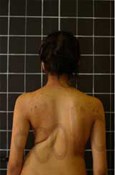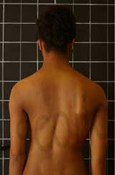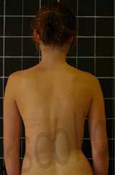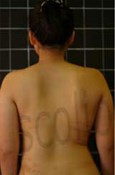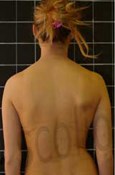Scoliosis in Teenagers
Causes of Scoliosis in Teens
Scoliosis in teens can be caused by numerous factors, and can still be idiopathic, meaning that there is no known cause. The common types of teenager scoliosis include:
- Congenital scoliosis - sideways curvature of the spine that was present at birth
- Idiopathic scoliosis - unknown cause of scoliosis and cannot be prevented; adolescent idiopathic scoliosis is estimated to affect between 3% and 4% of teenagers in the UK
- Neuromuscular scoliosis - associated with disorders of the brain, spinal cord and other neurological issues such as cerebral palsy, spina bifida, and more
Signs of scoliosis in teens may be subtle at first, making it difficult to determine whether scoliosis is present until symptoms are more pronounced.
Scoliosis Symptoms in Teenagers
Scoliosis in a teenager can present itself in numerous ways including physical signs like:
- Uneven shoulders
- Leaning to one side
- Visibly curved spine
- Ribs sticking out on one side
- Uneven hips
- Back pain
- Different leg lengths
Scoliosis symptoms in teenagers might not always be scoliosis, but anything more than a 10 degree curve of the spine is considered scoliosis. For proper diagnosis, please consult with your doctor.
The sideways curvature of scoliosis leads to one side of the body protruding out (rib, hip, shoulder), causing the body to appear as if it is constantly leaning to one side.
These symptoms can be distressing at any age, but it’s important to bear in mind that teenagers are particularly susceptible to feelings of low self-esteem and negative self-image as they try to fit in with their peers. We recommend seeking treatment as soon as possible if you suspect your teenager has scoliosis.
Scoliosis Diagnosis in Teenagers
Scoliosis might be difficult to detect in the early stages, particularly as symptoms are subtle at first. However, as symptoms begin to show, diagnosis is often straightforward.
Screening and Examination
For many, scoliosis might be first noticed at regular checkups and/or school-based screening programs. During a scoliosis screening or examination, the doctor will likely check the following:
- Posture
- Balance
- Height
The forward bend test (where you simply lean forward towards your toes) might also be performed to check for spinal deformity.
X-Rays and Other Tests
If scoliosis is suspected after a screening, then the diagnosis will be confirmed via an X-ray and other tests. X-rays are used to measure the degree of the spinal curvature, while other tests, such as MRI or CT scans might be used to help rule out other conditions or complications.
Scoliosis Treatment for Teenagers
There are a few different treatment options for teenagers with scoliosis. GPs are likely to recommend different treatments depending on the age of the patient and the severity of the spinal curve.
Here at Scoliosis SOS, we provide a non-invasive treatment approach to scoliosis, which includes tailored exercise and therapy programmes that cater to individual needs, goals, and preferences. No matter if you are looking to reduce spinal curvature and/or improve your mobility and flexibility, our scoliosis specialists are on hand to help. Seek a consultation to begin.
Observation
Observation involves keeping an eye on the curvature without starting any formal treatment. It is likely to be recommended if the patient’s spinal curvature is relatively mild at present.
Bracing
If the patient is still growing, doctors may recommend that they wear a scoliosis brace to prevent further curve progression. The most common type of brace is a rigid plastic shell called a ‘Boston brace’ that must usually be worn all day and removed only when showering/bathing.
Physiotherapy
Exercise-based therapy can be an effective course of treatment for teenagers with scoliosis, whether they’re in the early or late stages of adolescence. Our ScolioGold treatment programme is a non-invasive option that helps to correct the patient’s spinal curve while reducing pain and improving muscle balance.
Surgery
Spinal fusion surgery may be recommended for teenagers with severe cases of scoliosis. During this procedure, the surgeon anchors a series of rods to the spine using tiny hooks and screw. A bone graft is then applied – this eventually fuses with the spine with the aim of preventing further curve progression.
Before & After Treatment
We know that every patient’s symptoms, curvature and desired end goals are different. That’s why we tailor our ScolioGold method to suit you. We even offer flexible course dates so teenagers can be treated around commitments like school and college.
Here are some of the results we’ve been able to achieve for our teenage scoliosis patients:
Emotional and Social Effects of Scoliosis in Teenagers
Without a doubt, scoliosis can have emotional and social effects, especially for teenagers. Don’t be afraid to talk to someone that you trust, join a support group, or seek professional help if you are struggling with how to cope with your scoliosis diagnosis.
At Scoliosis SOS, we provide scoliosis treatment courses, as well as virtual therapy and in-person sessions to help you manage symptoms at a pace that is defined by you.
Case Study: Molly, 16 Years Old
Our treatment programme helped Molly to understand her condition and get it under control. Her school supported her by setting time aside for her to do her scoliosis exercises.
Looking for expert support and guidance when it comes to treating scoliosis in teenagers? Scoliosis SOS has got you covered with our high-quality treatment options, delivered by friendly, trained, and experienced scoliosis specialists. Contact us today to learn more about our services and/or for further enquiries about scoliosis treatment.
ExperienceMeet The Team
All of you are doing a great job and giving people hope. Your enthusiasm and hard work will never be forgotten.
"
